Portland, Oregon, averages 10 days per year over 90°F. This year we broke a record with 30 days over 90°F.
I’ve been working on my low-water front garden this year, and the heat (plus severe drought) have tested my choices. I garden in full sun on dry, rocky silt, and I water just enough to help new plants get established and keep them from frying. Here are the winners and losers for 2018. Photos are from August, unless stated otherwise.
Winners
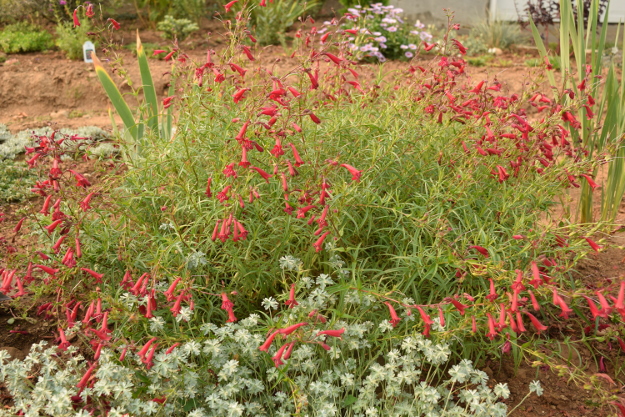
I’m really getting into penstemons. This is Penstemon kunthii, and it’s fabulous. It blooms and blooms and blooms, and the foliage is attractive and lush. Deadheading isn’t arduous, and it helps keep the plant looking thrifty and encourages more flower buds to form. P. kunthii is native to Mexico. Hardy to zone 7.

You may have wondered what that silvery plant was in front of the penstemon. That’s Geranium harveyi from my friend Evan. It got off to a slow start but eventually kicked it into high gear and made a good-sized swath. I haven’t seen any flowers yet; they’re supposed to be pink. But seriously, who needs flowers? This is awesome. Native to South Africa, hardy to zone 7b (or possibly much colder, depending on whom you talk to).
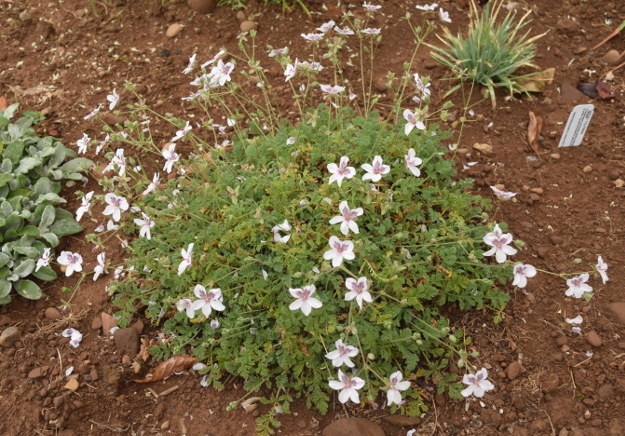
Here’s a geranium relative called Erodium ‘Stephanie’. I took this photo a few days ago as it was beginning its FOURTH flush of blooms. Each long-lasting wave follows closely on the heels of the last. Deadheading helps its appearance and isn’t as difficult as you’d think. The spent bloom stalks pull out cleanly and easily; you don’t need snips. ‘Stephanie’ is a hybrid selected in Scotland. Zone 5b.
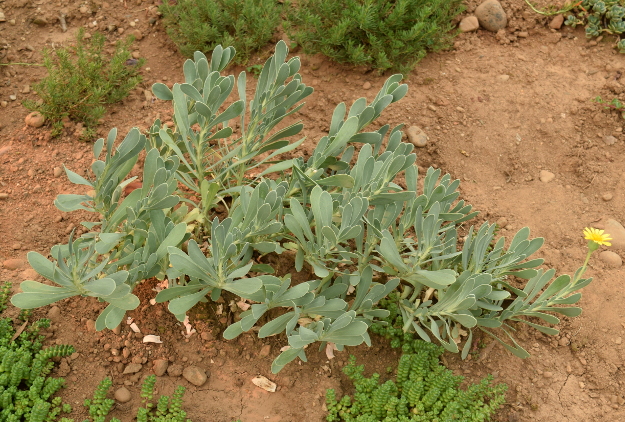
This fun succulent is one of my favorite plants of all time. It’s Othonna cheirifolia (Barbary ragwort), complete with one out-of-season flower (it normally flowers in late winter/early spring). The rubbery blue leaves are lined up in two ranks along the stems, producing an immensely satisfying geometric effect. From North Africa, hardy to zone 7.
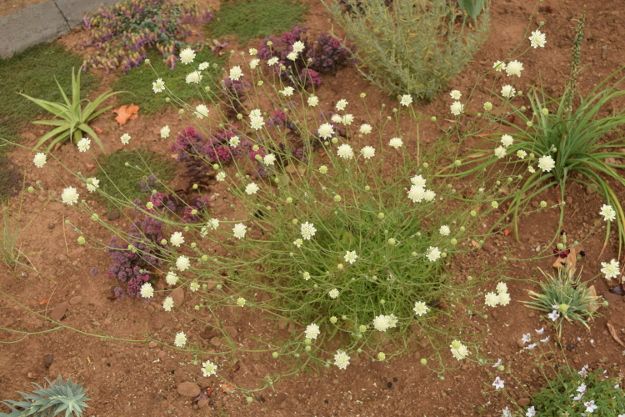
My friend Scott turned me on to Scabiosa ochroleuca, and I’m so happy. It’s a blooming machine. Deadheading isn’t strictly necessary, but I do it anyway. It’s kind of a pain, but only because there are so many flowers, which is a good thing. More drought tolerant than other scabiosas. Mediterranean native. Zone 5.
Bonus winners in this photo, from bottom-left going clockwise: Euphorbia rigida, Hylotelephium ‘Dazzleberry’, Thymus serpyllum ‘Coccineus’, Agave bracteosa, Origanum libanoticum, Lavandula stoechas. Kniphofia hirsuta ‘Fire Dance’ is a new purchase.
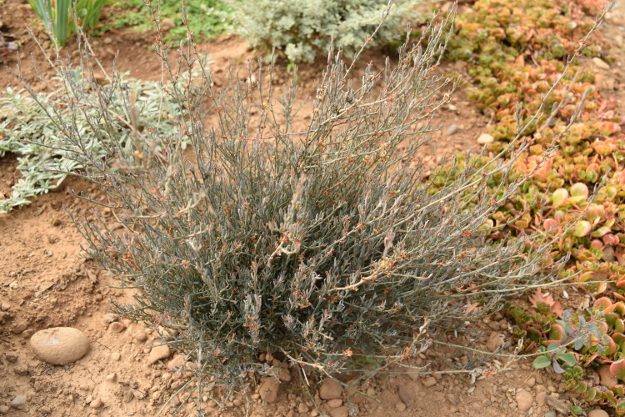
At Plant Nerd Night last March, Sean Hogan of Cistus Nursery said, “I happen to be a fan of plants that look dead but just keep getting bigger.” He was talking about Corokia cotoneaster (another winner in my garden), but I think that could also apply to Muehlenbeckia ephedroides. This quirky gray evergreen New Zealand plant makes me smile. It happily occupies a dry corner near the driveway, one of the furthest spots from the hose. Zone 7b.
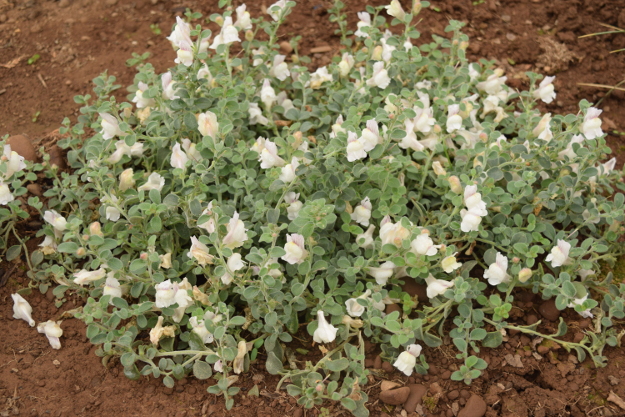
I’m an indecisive designer and move my plants around constantly. One type of plant you probably shouldn’t move is the super-drought-tolerant kind with sparse, stringy roots. Such as Antirrhinum hispanicum, Spanish snapdragon. I moved this plant anyway in the heat of summer with hardly any roots at all and it wilted badly. I kept it watered, and it made a full recovery. Tough. I got mine from Cistus Nursery. Zone 5.

Bearded irises were made for our climate. With a tiny bit of water and a little primping, the foliage can look handsome all season, and the spring flowers are dynamite. This is one I bought at Hortlandia in April called ‘Moose Tracks’.
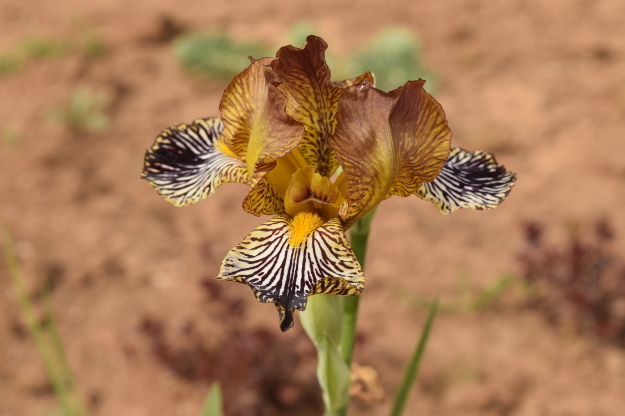
This is Moose Tracks in May. It’s a MTB (Miniature Tall Bearded), which means its flowers are smaller than traditional bearded irises. It gets 18 to 20 in. tall. Moose Tracks was bred by Oregonian Lynda Miller, who owns a fabulous little family nursery in Canby, Miller’s Manor Gardens.
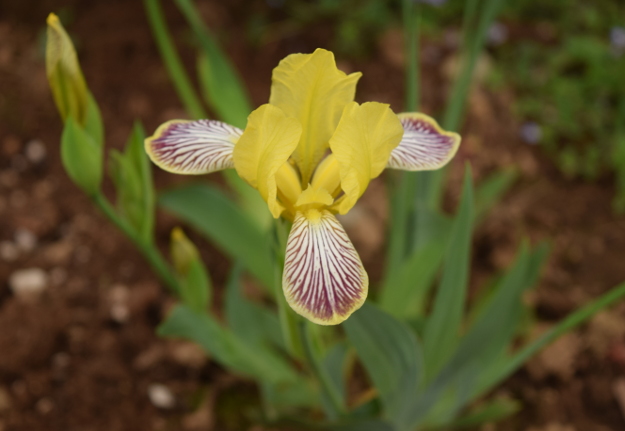
I got this species iris called Iris variegata, Hungarian iris, at Hortlandia a couple years ago. It has been used in the breeding of some bearded irises. Although it’s rare, it’s easy to grow and should be more popular. Hungarian and bearded irises are hardy almost everywhere.
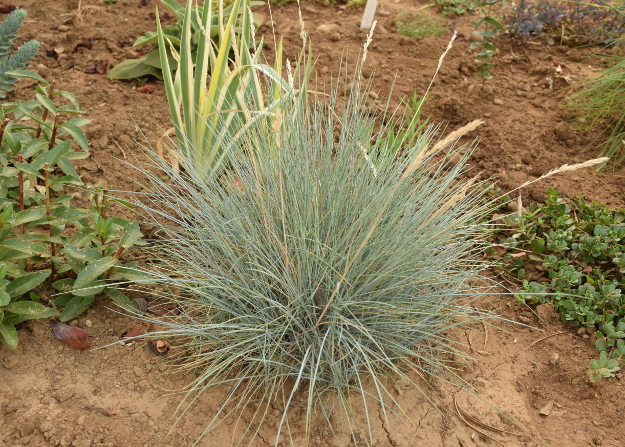
Blue fescues usually look spiffy in the spring but fall apart when the heat settles in. Also, they need dividing every few years to stay vigorous. This West Coast selection looks good ALL THE TIME and is long-lived. It’s Festuca rubra ‘Patrick’s Point’. It’s named after Greg Shepherd’s (of Xera Plants) childhood home in Northern California. I adore Greg, so it’s sweet to have a plant in my garden from his hometown. Zone 5b.
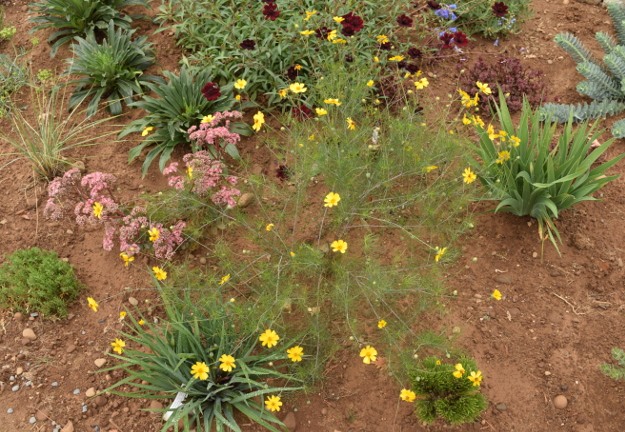
This was a rare find from the Dancing Oaks Nursery booth at PlantFest. It was labeled Thelesperma trifida and the tag said “drought tolerant,” so I took a chance on it. It ended up looking like a coreopsis that’s been grown in a closet, but I like it! Soft, spacey, and understated, and it is quite drought tolerant. I believe it’s native to the Plains and Rocky Mountain states. Hardy to zone 5.
Bonus winners in this shot, clockwise from bottom-left: Pacific Coast Iris ‘Blue Nebula’, Arenaria montana ‘Lemon Ice’, Hylotelephium ‘Petrified’, Stipa barbata, Crithmum maritimum, Digitalis parviflora, Cosmos atrosanguineus, Penstemon heterophyllus ‘Electric Blue’, Phedimus spurius ‘Voodoo’, Euphorbia myrsinites, Iris ‘Moose Tracks’, Pinus leucodermis ‘Beran Conica’.
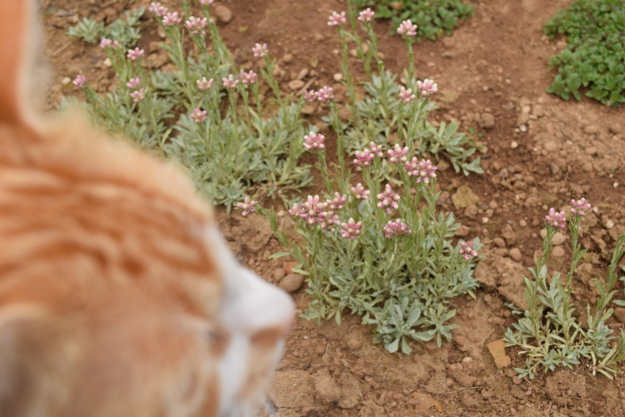
Pussytoes! This has been a wonderful plant for my dry garden: Antennaria dioica ‘Rubra’. In May it gets these cute flowers. Then the fluffy seedheads form, which are attractive for a long, long time.
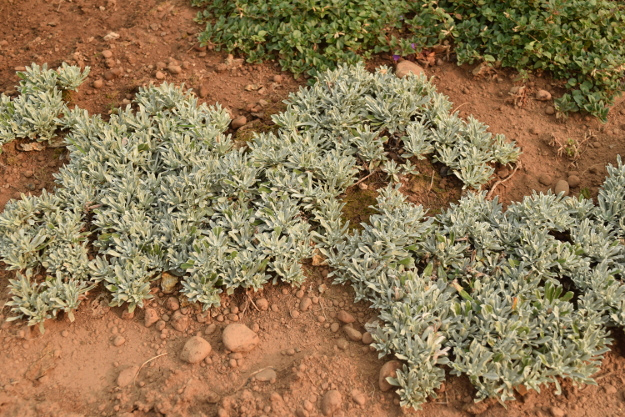
When you finally cut them down, you’re left with a nice, tight, silvery mat. This is in August. Easy to divide and make more. Zone 3.
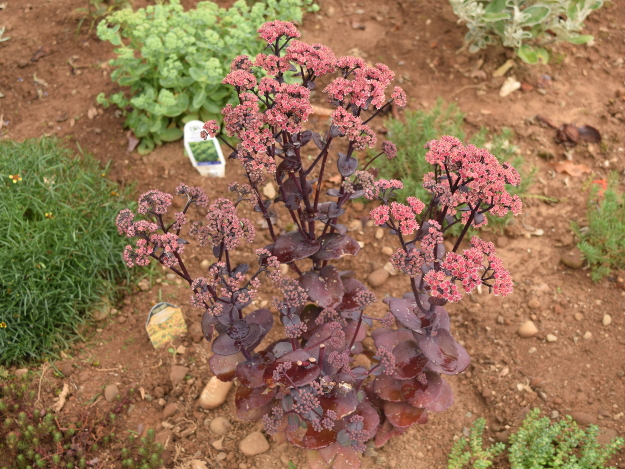
So many sedums! Sedums are my favorite plants. If I had to choose one favorite upright purple type, it would be ‘Blue Pearl’. Big, rounded, rubbery, purple leaves with a bluish cast, dark stems, rich carmine-pink flowers. Aphids were terrible on sedums this year, but Blue Pearl was spared. This is part of Chris Hansen’s Sunsparkler series, but I can find no indication that he patented it. I think it’s his best one. Zone 4.

I was also very impressed with the groundcover sedum, Phedimus kamtschaticus, this year. After its first showy flush of blooms, it put out a second, lighter flush! This is its second wave in August. Great drought tolerance, vibrant foliage, neat habit.

And, last fall, Phedimus kamtschaticus did this! Zone 3.
Losers
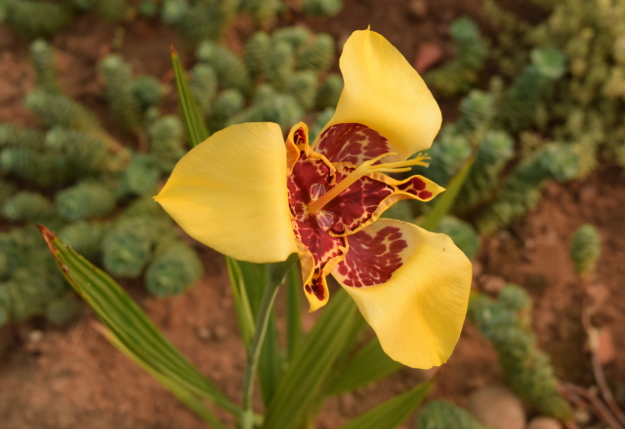
Tigridia pavonia, tiger flower. Why would I put this on the loser list? I’ll tell you why—each bloom lasts a mere 12 hours, and I got three blooms. You know what, though? I’m keeping it. That flower is amazing. Native to Mexico, hardy to zone 8.
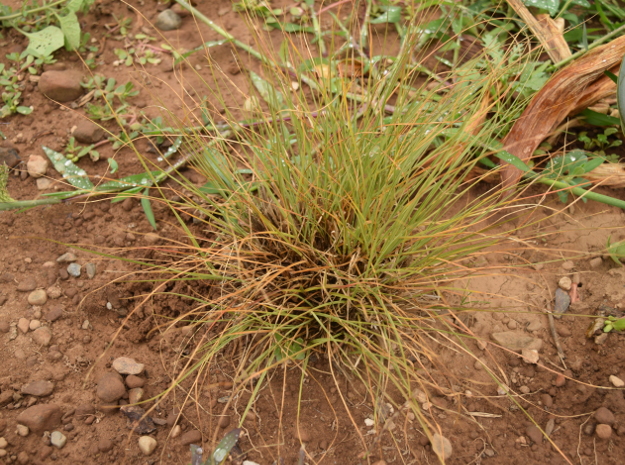
I’m curious how this plant does for other Pacific Northwesterners. It’s Sporobolis heterolepis, prairie dropseed. It’s a small, slow-growing, warm-season grass from the Great Plains that’s supposed to smell like popcorn in the fall. I want to like it, but I don’t think it cared for our long, cool spring. It just sat there looking pathetic and I got impatient and yanked it out.
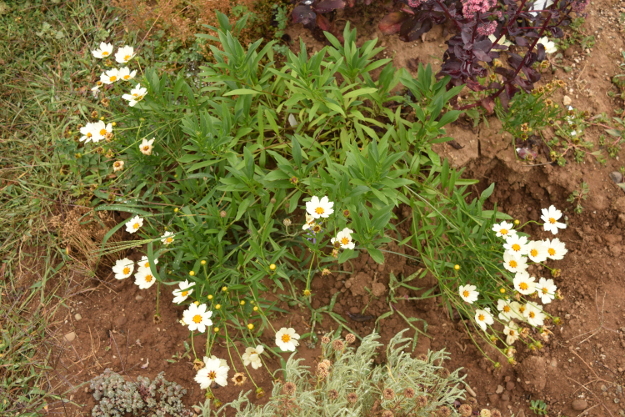
Coreopsis ‘Star Cluster’ never made it out of the holding bed because it was floppy, bloomed late, and didn’t have many flowers. I was very pleased with a red and yellow selection from Terra Nova called Honeybunch ‘Red and Gold’, however. And I have long been a fan of a cool caramelly-orange cultivar named ‘Sienna Sunset’.
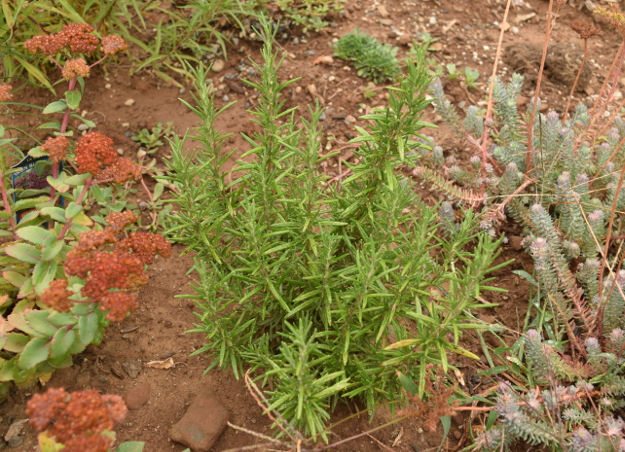
I like rosemary for its blue winter flowers, drought tolerance, and evergreen foliage (hate the fragrance), but ‘Huntington Carpet’ was a disappointment. It just sat there and didn’t grow. Doesn’t seem like it wants to be much of a carpet.
Hylotelephium ‘Gooseberry Fool’ to the left was a letdown as well—short bloom time. Petrosedum rupestre ‘Blue Bird’ to the right—big, big winner.

Ceanothus gloriosus ‘Heart’s Desire’ never took off. It just sat there looking small and sad.
I have had lots of dead leaves in my Ceanothus thyrsifolius ‘Victoria’, too. I clean it up by spraying it with the hose and it looks all right.

I love everything about Hylotelephium ‘Vera Jameson’ except for the fact that it splays open. Such a shame. Bye-bye.
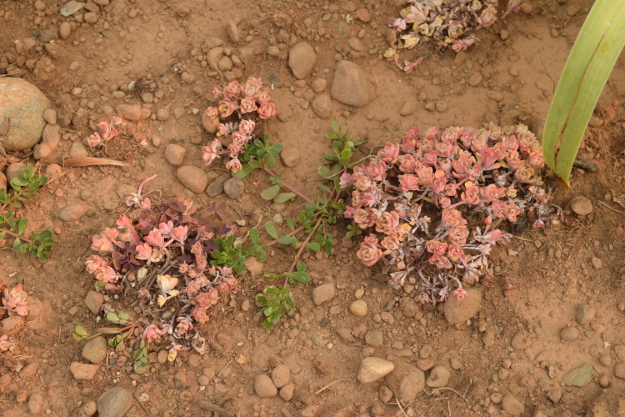
I was surprised to have terrible luck with Sedum spathulifolium this year. I had several varieties that fell apart after they bloomed. This is ‘Cape Blanco’. S. spathulifolium is native, so I thought it would be easy, but I think it needs a little shade and moisture to look its best.
Do you have any low-water favorites you think I should try? Please let me know in the comments!


Amy,
Spot on with deadheading the Scabiosa! I don’t keep up with doing that here (Monroe, OH), and seedlings pop up like crazy.
Sure do wish the G. harveyi was another zone hardy!
Cheers!
Oh, I didn’t even think about reseeding. I just want to keep the blooms coming!
Great review of winners and losers this summer. Penstemon kunthii is gorgeous! Geranium harveyi does take a bit of time to get going, especially if it gets cut back in spring, which I usually do. It only blooms sparsely for me, which I like because the foliage is the main draw. I’ve been considering Erodiums more. I had bad results with E. chrysanthum, but it was in a bad spot. I can’t wait to plant Muehlenbeckia ephedroides! Planning to pick some up from Xera soon. Also planning to plant a lot of ‘Patrick’s Point’ Festuca. I think you probably got a mislabeled rosemary. Definitely not ‘Huntington Carpet’. How old is that Ceanothus? They can take a little time to settle in and really start growing.
I have Erodium chrysanthum in a holding bed but never planted it out because I wasn’t thrilled with it. The foliage is very nice but I was hoping for more flowers. Wish I had some Muehlenbeckia to share, I tried to propagate it and failed all three times. It would be great for your garden along with Patrick’s Point. The Ceanothus I planted last fall. That blue may be too intense there anyway.
I am wondering if you planted any Arctostaphylos? And what?! You don’t like the smell of rosemary?
Yes, Arctostaphylos is phenomenal! I have ‘Louis Edmonds’, ‘Diablo’s Blush’, ‘Rosy Dawn’, ‘Monica’, ‘Austin Griffiths’, and A. nummularia. Rosemary is almost as gross-smelling as lavender.
Looks like quite a few choice plants came through the heat. I just planted Erodium ‘Stephanie’ — chrysanthum is wonderful here among succulents, flowering or not. And that little dwarf bearded iris ‘Moose Tracks’ is fabulous! I wonder if the leaves would look as good here, possibly another slim plant among succulents…wonderful report, thanks!
Moose Tracks is a smaller-flowered iris but it is tall. The foliage does look nicer than my other, old fashioned, tall bearded irises, though.
I had a similar problem with the cape blanco in my south-facing hellstrip. It seems to be recovering somewhat now that the weather has cooled off, but I remain skeptical.
Yeah, I thought of it as a full-sun plant, but it really needs a bit of shade. Or at least some more water.
This really is the world’s best gardening blog…at least one of them for our climate. I enjoy your writing! Also agree with Cape Blanco. Mine are growing happily in half to three quarters shade. And melted away in hot, full sun.